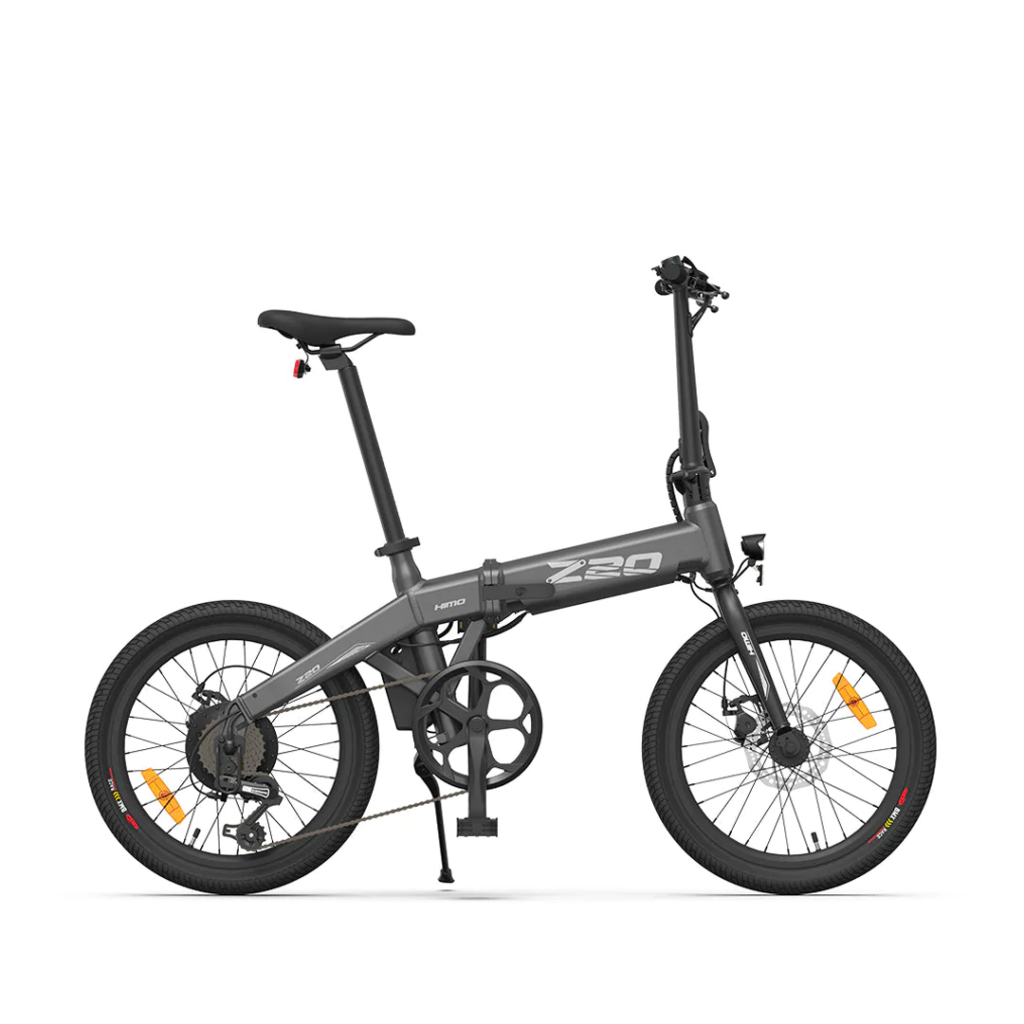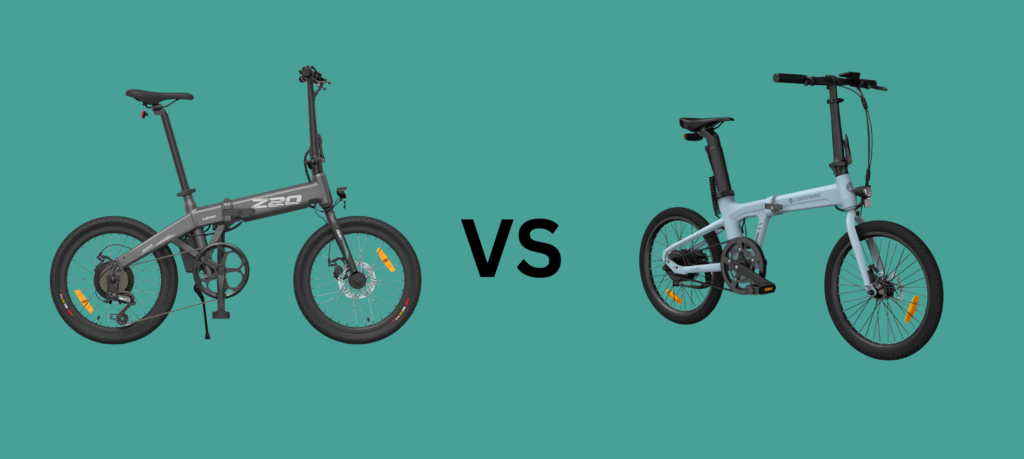
When it comes to electric bikes, price, performance, and features often dictate their value for money. The Xiaomi Himo Z20 ebike perfectly encapsulates this debate with its dual electrical assist modes and a robust 36V 10Ah battery offering a range of around 60km. At a price point of RM 3,099 and a weight of 21.6kg, it’s easy to see its appeal.
However, as we delve deeper into the comparison, it becomes evident that the ADO A20 Lite, with more advanced features, including three electrical assist modes and lighter weight at 16kg, presents a much better value for those seeking a top-tier ebike experience. As we unpack the Xiaomi Z20 ebike further, let’s explore whether it truly lives up to its price tag or if alternatives like the ADO A20 Lite reign supreme.
Overview of the Xiaomi Himo Z20 Ebike

The Xiaomi Himo Z20 ebike offers an intriguing mix of features that cater to various biking needs. With its dual electrical assist modes—Dynamic Sports Mode and Cool Mode—users can tailor their ride experience based on preference and terrain. Powered by a robust 36V 10Ah Li-ion battery, the Xiaomi Z20 ebike promises a range of approximately 60 km, making it a reliable option for both city commutes and leisurely rides. Weighing in at 21.6 kg and sporting a maximum load capacity of 100 kg, this ebike is constructed to accommodate most riders comfortably.
The mechanical disc brakes ensure decent stopping power, while the chain system provides a familiar cycling experience for those accustomed to traditional bikes. Priced at RM 3,099, the Xiaomi Z20 ebike appeals to consumers looking for a balance between performance and affordability. However, when comparing it to the ADO A20 Lite, which retails at RM 3,699, the value proposition of the Xiaomi Z20 ebike seems less compelling.
The A20 Lite features three electrical assist modes and benefits from a 36V 9.6Ah Li-ion battery that also provides a similar range of about 60 km. Notably lighter at 16 kg and equipped with hydraulic brakes, the A20 Lite offers enhancements that elevate its overall performance and comfort. Both bikes have a 100 kg load capacity, but the advanced features of the ADO A20 Lite make it a stronger contender in the value for money debate, leaving potential buyers with an important consideration to make.
Key Features and Specifications of the Xiaomi Z20
The Xiaomi Z20 ebike is equipped with a dual electrical assist mode, allowing riders to choose between Dynamic Sports Mode for an exhilarating ride or Cool Mode for a more relaxed experience. Powered by a 36V 10Ah Li-ion battery, the Xiaomi Z20 ebike offers a respectable range of approximately 60 kilometers on a single charge, making it suitable for both daily commuting and leisurely rides. Weighing in at 21.6 kilograms, it can support a maximum load of 100 kilograms, ensuring durability and stability while riding.
The mechanical disc brakes provide reliable stopping power, making the Xiaomi Z20 ebike a sensible option for those who value safety and performance in their ride. At a price point of RM 3,099, it’s a mid-range electric bike that competes well in its category, but the features may leave some potential buyers wanting more for their investment. When compared to its main competitor, the ADO A20 Lite, the Xiaomi Z20 ebike‘s value proposition starts to diminish.
The ADO A20 Lite boasts three electrical assist modes and has a slightly lower weight of 16 kilograms, which adds an advantage in portability. With a similar range of about 60 kilometers from a 36V 9.6Ah Li-ion battery, the ADO model also comes with advanced hydraulic brakes, enhancing performance and safety. Priced at RM 3,699, while slightly more expensive, many users find that the improved features and weight advantages of the ADO A20 Lite ultimately make it a much better value for money compared to the Xiaomi Z20 ebike.
Comparative Analysis: Xiaomi Z20 vs. ADO A20 Lite

When evaluating the Xiaomi Z20 ebike and the ADO A20 Lite, it becomes evident that there are distinct differences in features and performance that affect their overall value for money. The Xiaomi Z20 ebike is equipped with a dual electrical assist mode, granting riders either a Dynamic Sports Mode for a more vigorous ride or a Cool Mode for a relaxed cruise. It boasts a 36V 10Ah Li-ion battery with a maximum range of approximately 60km, supporting a maximum load of 100kg. However, it weighs 21.6kg, which may be cumbersome for some users. Priced at RM 3,099, the Z20’s mechanical disc brakes and chain system present some limitations compared to its competitor.
On the other hand, the ADO A20 Lite comes with three electrical assist modes and a slightly less powerful 36V 9.6Ah battery with the same range of about 60km, yet it is notably lighter at only 16kg, making it far more maneuverable and user-friendly. Its hydraulic brakes and belt system enhance overall riding efficiency, which is critical for both safety and performance. The price point for the ADO A20 Lite is RM 3,699, placing it slightly higher than the Xiaomi Z20 ebike, yet many argue that the added benefits justify the cost.
With more advanced braking technology and a lighter frame for easier handling, the ADO A20 Lite offers superior riding dynamics and a better user experience. In essence, while the Xiaomi Z20 ebike presents a compelling option, the ADO A20 Lite emerges as the better investment, combining performance, weight efficiency, and braking technology for avid cyclists seeking excellent value for money.
Electrical Assist Modes: Which is More Beneficial?
In the world of electric bikes, the efficiency of electrical assist modes can significantly influence the riding experience. The Xiaomi Himo Z20 offers a dual electrical assist mode, allowing riders to choose between Dynamic Sports Mode for a more vigorous ride or Cool Mode for leisurely trips. This flexibility caters to different riding preferences and conditions. On the other hand, the ADO A20 Lite has three electrical assist modes that provide a broader range of choices when it comes to optimizing performance and battery usage. This feature makes the A20 Lite more advantageous, especially for users who want to customize their riding experience based on varying terrains and energy levels.
Moreover, both bikes are equipped with impressive battery capacity, giving them similar ranges of about 60km. The Xiaomi Z20 ebike, however, weighs 21.6kg compared to the lighter 16kg of the ADO A20 Lite, which potentially enhances maneuverability and ease of transport for the latter. Given the more versatile electrical assist options, lighter weight, and superior braking system of the ADO A20 Lite, it arguably presents better value for money than the Xiaomi Z20 ebike. Therefore, if you’re considering an electric bike that offers a broader range of assistive features and better overall handling, the ADO A20 Lite is the standout option.
Battery Performance and Range: Xiaomi Z20 vs. ADO A20 Lite
When comparing the battery performance and range of the Xiaomi Z20 ebike to the ADO A20 Lite, both e-bikes are equipped to cover approximately 60 kilometers on a single charge, but there are significant differences in their battery specifications. The Xiaomi Z20 ebike comes with a robust 36V 10Ah Li-ion battery, contributing to its dynamic dual electrical assist modes: Dynamic Sports Mode and Cool Mode. However, the added weight of 21.6 kg means that riders may experience a slightly less nimble ride compared to the lighter ADO A20 Lite, which utilizes a 36V 9.6Ah Li-ion battery and weighs in at only 16 kg.
Although both e-bikes can support a maximum load of 100 kg, the ADO A20 Lite‘s more efficient battery design enhances its overall performance, particularly for those looking for a lightweight and agile option for commuting or recreational use. Moreover, while both e-bikes offer similar ranges, the hydraulic brakes on the ADO A20 Lite provide superior stopping power and control, which can be crucial for safety and confidence during rides.
The belt system of the ADO A20 Lite also promises lower maintenance compared to the chain system on the Xiaomi Z20 ebike. Ultimately, while the Xiaomi Z20 ebike offers a solid construction and features, the ADO A20 Lite emerges as the better value for money, thanks to its lighter build, superior braking system, and lower maintenance needs, catering perfectly to those who prioritize performance alongside cost-effectiveness.
Handling and Comfort: Weight and Build Quality
When considering the handling and comfort of the Xiaomi Himo Z20 ebike, it’s essential to examine its weight and build quality. Weighing in at 21.6kg, the Z20 is relatively heavier compared to other options on the market. This weight is largely due to its robust design and features, including a chain system and mechanical disc brakes. However, for some users, especially those navigating steep inclines or uneven terrains, this added weight might prove to be a disadvantage; it can affect maneuverability and make longer rides less enjoyable. The ride quality can still be balanced out by the dual electrical assist modes, which enhance performance but do not fully compensate for the overall heft of the bike.
In contrast, the ADO A20 Lite stands out in terms of handling and comfort with its lighter frame of just 16kg. This reduced weight, coupled with a belt system and hydraulic brakes, makes for a smoother and more responsive riding experience. Despite the A20 Lite’s slightly higher price point of RM 3,699, its superior handling and build quality arguably offer better value for money. Thus, while the Xiaomi Z20 is a capable ebike, those prioritizing comfort and ease of handling may find more satisfaction in investing in the ADO A20 Lite instead.
Pricing and Value for Money: Is Xiaomi Z20 Worth It?
When it comes to pricing and value for money, the Xiaomi Himo Z20 boasts a competitive price of RM 3,099. Featuring a dual electrical assist mode and a sturdy 36V 10Ah Li-ion battery that offers a range of about 60km, the Z20 is certainly appealing. However, at a weight of 21.6kg, it might not be the most lightweight option available. With a mechanical disc brake system ensuring reliable stopping power, the Z20 has its merits but raises questions about whether it stands out when compared to competitors in the market.
On the other hand, the ADO A20 Lite presents an even more compelling case for value with a price tag of RM 3,699. Though slightly higher, its advantages, such as a lighter weight of 16kg and a belt system contributing to smoother rides, make it attractive. The inclusion of hydraulic brakes adds further reliability. With three electrical assist modes and a similar range, the ADO A20 Lite clearly provides better overall features, positioning it as a better value in the ebike market compared to the Xiaomi Himo Z20.
Final Thoughts on Choosing Between Xiaomi Z20 and ADO A20 Lite
When comparing the Xiaomi Z20 ebike with the ADO A20 Lite, potential buyers must weigh the features and overall value for money. The Xiaomi Himo Z20 is equipped with a dual electrical assist mode and boasts a 36V 10Ah Li-ion battery, offering a decent range of about 60 kilometers. However, at a price of RM 3,099 and a weight of 21.6 kg, it may not be the most convenient option for everyone. Its mechanical disc brakes are adequate but can lack the smoothness and efficiency offered by more advanced braking systems.
On the other hand, the ADO A20 Lite stands out as a much better value for money. With three electrical assist modes, a lighter weight of only 16 kg, and advanced hydraulic brakes, it enhances the overall riding experience. The 36V 9.6Ah Li-ion battery also provides a similar range of about 60 kilometers, but at a higher price of RM 3,699, the added benefits might justify the cost. Ultimately, buyers looking for a well-rounded e-bike with improved features may find the ADO A20 Lite to be a more appealing choice over the Xiaomi Z20 ebike.
Final Thoughts on the Xiaomi Z20 Ebike
In summary, while the Xiaomi Z20 ebike offers some appealing features such as dual electrical assist modes and a decent battery range, its price of RM 3,099 might not deliver the best value for money, especially when compared to competitors. The build and performance standards are satisfactory, but riders looking for a more lightweight option and superior braking system may find better worth in choices like the ADO A20 Lite. Priced at RM 3,699, it boasts a lighter frame, advanced hydraulic brakes, and three electrical assist modes, making it a stellar alternative for those prioritizing performance and efficiency.
Ultimately, the decision comes down to individual preferences and riding requirements. If you’re in the market for a reliable and budget-friendly ebike, the ADO A20 Lite from EKO Life MY presents a much better proposition with comparable features and enhanced specifications. However, if you have your heart set on the Xiaomi Z20 ebike, it’s essential to weigh your options carefully and consider what matters most in your cycling experience.

Love to see a summary of the blog post. It makes it easier for me to decide if I want to read the whole thing or not
Hi Rachel, we completely understand the importance of a clear summary. At Eko Life Malaysia, we strive to make it easy for our readers to decide whether to delve into our blog posts or not. We appreciate your feedback and will definitely take it into consideration as we continue to create engaging content for our audience. If you have any further questions or need assistance, please feel free to contact us at [email protected] or +60 3-7890 3042.
I like how the summary is short and sweet. It’s easy to understand without spending too much time reading
Thank you, Sophia! We’re glad you found the summary concise and easy to understand. At Eko Life Malaysia, we strive to make information accessible to everyone, while also ensuring it’s easy to digest. If you have any questions or need further clarification on anything, please don’t hesitate to reach out to us at [email protected] or +60 3-7890 3042.
I’m a bit disappointed that it’s not a full blog post yet. I was expecting more from the title
Hi Ryan, sorry to hear that the blog post didn’t meet your expectations. We appreciate your feedback and would love to create a more in-depth post for you. If you’re interested in learning more about our services or would like to suggest a specific topic for a future blog post, please don’t hesitate to reach out to us at [email protected] or call us at +60 3-7890 3042.